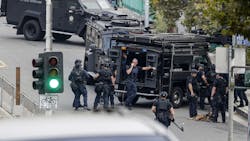LAPD Report: No Culture of Violence in SWAT Unit
The Los Angeles Police Department's SWAT unit rarely resorts to using force and does not glorify violence as one former member alleged, a newly released internal report concluded.
Police Chief Michel Moore ordered the report, which examined all of the incidents over the last decade in which teams from the specially trained platoon were deployed, amid allegations of misconduct. The review, Moore previously said, was intended to determine whether "any potential problems or patterns exist in how the unit uses force."
This year, The Times reported that a member of the unit said "happy hunting" to other SWAT officers before a fatal police shooting. And previously a former SWAT member alleged in a lawsuit that a group of influential officers known as the "SWAT mafia" encouraged violence among the unit.
In presenting the report to the civilian Police Commission, which oversees the department, Deputy Chief David Kowalski said the "happy hunting" comment, while troubling, was an isolated incident.
Commission President William Briggs pressed police officials on whether their investigation had revealed the presence of officer "cliques" similar to the gang-like groups of deputies that operate within the Los Angeles Sheriff's Department.
"We're here as oversight of the LAPD; we certainly don't want to have or seem to have that sort of situation," Briggs said.
Kowalski said there was nothing to suggest the presence of a SWAT mafia.
"I think with SWAT officers, we expect more, because of the national and probably worldwide attention that LAPD SWAT does bring," he said. "I'm satisfied with the findings."
SWAT officers did not use force in 1,245 of the 1,350 incidents they responded to between 2012 and 2022, the report found. Members of SWAT, which stands for Special Weapons and Tactics, are typically called into fraught situations involving, for example, hostages, barricaded suspects and active shooters. They also often serve high-risk search warrants.
The most common type of force used by SWAT officers, in roughly 6% of incidents, was "non-categorical," a term the LAPD uses when the force does not lead to a person's hospitalization or involve head strikes or neck restraints. Over the 10-year span, SWAT personnel were involved in 20 on-duty shootings, peaking at four in 2017, the report found.
At the same time, the report showed that the number of SWAT deployments had risen in recent years, from 90 in 2019 to 129 in 2021. There had been 73 deployments through this June, the review found.
Moore told the commission that at least part of the reason for the increase was a recent rise in violent crime.
At Tuesday's commission meeting, he and other department leaders argued the report shows that SWAT members today use force less frequently than in previous decades and that the unit operates with greater restraint and precision than in years past.
"Is there room for improvement? Yes, anytime there's force, anytime there's loss of life, there's always room for improvement," Assistant Chief Al Labrada said at the meeting.
Officials credited changes in policy and other safeguards, such as adopting body cameras, assigning a police psychologist to weigh in on all crisis negotiation situations, and overhauling how officers are recruited for the unit. The unit also worked with the Office of Constitutional Policing and Policy to overhauled its protocols for carrying out search warrants after the death of Breonna Taylor, a Black woman who was fatally shot in her Kentucky home in 2020 by police who burst in without warning.
Before 2008, the report said, the process by which officers were selected for SWAT tended to "under-emphasize negotiating skills, patience, empathy, and flexibility, while over-emphasizing physical prowess and tactical acumen."
In three cases reviewed in the report, officers were injured during an operation. The review also noted seven incidents in which SWAT members did not use deadly force after being fired on by suspects.
Five officers have been involved three shootings each, the report found. Two of those officers were present at the incident in which a SWAT member made the "happy hunting" comment as he and other members were preparing to confront a barricaded suspect.
The officer who made the comment has not yet been named; an internal investigation into the remarks is ongoing.
The comment was discovered by a commanding officer who was reviewing body-camera video from the incident.
Hamid Khan of the Stop LAPD Spying Coalition criticized the report for failing to capture the impact of what he said was the department's increased reliance on SWAT for "low-level offenses" and other situations that don't call for a heavily armed police response. As an example, he said, the unit's array of robots and drones has been used to monitor protests or traffic jams.
"The whole idea of mission creep and how it expands over time has been very evident of how SWAT has been used," Khan said. "That's where the doublespeak comes in: On the one hand, they're claiming that [use of force] has declined ... while just expanding the role of these tactical units into these day-to-day incidents, like traffic, protests and rallies and things," he said.
This story originally appeared in Los Angeles Times.
©2022 Los Angeles Times. Visit latimes.com. Distributed by Tribune Content Agency, LLC.
